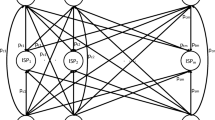Abstract
A Server-Proxies-Users communication system is studied by using Stackelberg strategy theory of game. A new model, in which the server, proxies and users are not equal is established, and that is a threelevel programming. The solution existence of the model is proved.
Similar content being viewed by others
References
C. D. Murta and V. A. F. Almeiida,Characterizing response time of WWW caching proxy Servers, Workload Characterization: Methodology and Case Studies, (1999), 69–75.
E. Chang and A. Zakhor,Admission Control and Data Placement for VBR Video Servers, First IEEE international conference on image processing, Austin, November (1994), 278–282.
E. P. Markatos, D. N. Found, M. D. Flouris and M. G. H. Katevenis,Web-conscious storage management for Web proxies, IEEE/ACM Transaction on Networking10 (2002), 735–748.
E. W. Knightly and N. B. Shroff,Admission Control for Statistical QoS: Theory and Practice, IEEE Networking, March/April (1999), 20–29.
H. Yaiche, R. R. Mazumdar and C. Rosenberg,A Game Theoretic Fraework for Bandwidth Allocation and Pricing in Broadband Networks, IEEE/ACM Transaction on Networking8 (2000), 667–678.
K. H. Beak, Y. W. Park and K. D. Chung,A proxy server management policy using patching scheme for continuos media streams, IEEE International Conference on Multimedia and Expo (2001), 491–494.
M. R. Howard and M. B. J. Jansen,A Proxy Server Experiment: an Indication of the Changing Nature of the Web, Proceedings. 7th International Conference on Computer Communications and Networks13 (1998), 646–649.
O. L. Margasarian,Nonliear programming, McGraw-Hill, New York, 1969, Reprinted by SIAM Publications, 1995.
R. Guerin, H. Ahmadi and M. naghshined,Equivalent Capacity and Its Application to Bandwidth Allocation in High-Speed Networks, IEEE J-SAC9 (1991), 968–981.
S. H. Low and D. E. Lapsley,Optimization Flow Control-I: Basic Algorithm and Convergence, IEEE/ACM Transaction on Networking7 (1999), 861–874.
T.Basar and G. J. Olsder,Dynamic Noncooperative Game Theory, Academic Press, 1982.
Y. P. Zheng and J. B. Cruz Jr,Stackelberg Strategies and Incentives in Multipersion Deterministic Decision Problems, IEEE Transaction on Systems, Man, and Cybernetics,Vol. SCM-14, No. 1, (1984), 10–24.
Author information
Authors and Affiliations
Corresponding author
Additional information
Hai-Shan Han is a vice-professor and a Ph. D. student under the supervision of prof. Xia, he received his master's degree from Dalian University of Technology in 2000. His research interesting focus on Network optimization, multilevel optimization and game theory in the multimedia communication systems.
Zun-Quan Xia is a professor in Department of Applied Mathematics, Dalian University of Technology, Dalian, China. He graduated from Institute of Mathematics, Fudan University, Shanghai, as a graduate in 1968. His research areas are (smooth, nonsmooth, and numerical) optimization and applications in science and technology, OR methods and applications.
Rights and permissions
About this article
Cite this article
Han, HS., Xia, ZQ. A stackelberg model for Server-Proxies-Users systems. JAMC 17, 185–194 (2005). https://doi.org/10.1007/BF02936048
Received:
Revised:
Issue Date:
DOI: https://doi.org/10.1007/BF02936048




